# Essential Equipment for Caring for White Egg Orchids at Home

Caring for White Egg Orchids (Dendrobium) at home requires specific tools and equipment to ensure they thrive. Understanding these necessities will help you create an ideal environment for your orchids, leading to healthy growth and beautiful blooms. Below is a comprehensive guide detailing the essential equipment needed for effective orchid care.
## 1. Potting Supplies
### 1.1 Pots
Choosing the right pot is fundamental to the health of your orchids. Opt for pots designed specifically for orchids, which usually have several drainage holes. This allows excess water to escape and prevents root rot. Here are some options:
– **Plastic Pots**: Lightweight and retain moisture, making them a good choice for beginners.
– **Terracotta Pots**: Porous and provide excellent air circulation, helping to keep roots dry. Ideal for those who prefer a more traditional look.
– **Orchid Baskets**: Great for epiphytic orchids, these allow for maximum airflow and drainage, mimicking the natural growing conditions of orchids.
### 1.2 Potting Media
The potting mix is crucial for the health of your White Egg Orchids. Standard potting soil is unsuitable because it retains too much moisture. Instead, consider the following orchid potting media:
– **Bark Chips**: Made from fir or pine, bark chips provide good drainage and air circulation around the roots.
– **Coconut Coir**: A sustainable option that retains moisture while allowing for good drainage.
– **Perlite**: Often mixed with bark or coir, perlite improves aeration and drainage.
– **Sphagnum Moss**: Retains moisture but should be used sparingly, as it can hold too much water if not monitored.
## 2. Watering Equipment
### 2.1 Watering Can
A watering can with a narrow spout is ideal for orchids. This allows for precision watering, targeting the potting mix without over-saturating the plant. Consider a can with a long handle for better control, especially when reaching higher shelves.
### 2.2 Humidity Tray
Orchids thrive in humid environments. A humidity tray filled with water and pebbles can help maintain moisture levels around your plants. Place the tray near your orchids, but ensure that the pot does not sit directly in the water, as this can lead to root rot.
### 2.3 Water Quality Tester
Testing the quality of your water is essential for the health of your orchids. Chlorine, fluoride, and other chemicals can harm orchids over time. Use a water quality tester to ensure your watering source is safe for your plants.
## 3. Lighting Equipment
### 3.1 Grow Lights
Natural light is important for orchid growth, but sometimes it isn’t sufficient, especially during winter months or in dimly lit areas. Grow lights can supplement natural light effectively. Look for:
– **LED Grow Lights**: Energy-efficient and produce less heat, making them ideal for orchids. They come in full-spectrum options that mimic sunlight.
– **Fluorescent Lights**: Affordable and effective for providing light to orchids. Position them about 12-24 inches above the plants.
### 3.2 Light Meters
A light meter can help you measure the light intensity in your orchid’s location. This tool ensures that your orchids receive the right amount of light, preventing issues such as leaf burn or inadequate growth.
## 4. Temperature and Humidity Control
### 4.1 Thermometer
Monitoring the temperature is essential for the health of your White Egg Orchids. Use a thermometer to keep track of the temperature in the growing area. Ideal temperatures range from 65°F to 75°F (18°C to 24°C) during the day, with a slight drop at night.
### 4.2 Hygrometer
A hygrometer measures humidity levels in your home. Orchids prefer humidity levels between 40% and 70%. If your home is too dry, consider using additional humidity equipment to create a suitable environment.
### 4.3 Humidifier
A humidifier can help maintain the necessary humidity levels for your orchids. Choose a model that is easy to operate and clean. Position it near your orchids, ensuring that the mist is directed towards them.
## 5. Fertilizing Equipment
### 5.1 Orchid Fertilizer
Using a specialized orchid fertilizer is crucial for providing the nutrients that your White Egg Orchids need. Look for fertilizers high in nitrogen, phosphorus, and potassium. A balanced 30-10-10 formula is often recommended during the growing season, while a 10-30-20 formula may be more suitable during the blooming phase.
### 5.2 Measuring Tools
Accurate measurement of fertilizer is essential. Use measuring spoons or a small scale to ensure you are using the correct amount of fertilizer based on the manufacturer’s instructions.
### 5.3 Fertilizer Applicator
Consider using a fertilizer applicator for easier and more precise distribution of nutrients around your orchids. This tool can help ensure that the fertilizer reaches the roots without harming the plant.
## 6. Maintenance Tools
### 6.1 Pruning Shears
Regular maintenance, such as trimming dead leaves and spent flowers, is essential for orchid health. Use sharp, sterilized pruning shears to avoid damaging the plant and to prevent the spread of diseases.
### 6.2 Sphagnum Moss
For orchids that need additional moisture or for those that are sensitive to drying out, using sphagnum moss can be beneficial. It can be placed on top of the potting mix or used to line the pot to help retain humidity.
### 6.3 Soft Brushes
Soft brushes can be used to remove dust and debris from the leaves of your orchids. Keeping the leaves clean is important for photosynthesis and overall plant health.
## 7. Pest Control Equipment
### 7.1 Insecticidal Soap
Insecticidal soap is a safe and effective way to manage pests such as aphids, spider mites, and mealybugs. Keep a bottle on hand to treat any infestations promptly.
### 7.2 Neem Oil
Neem oil is a natural pesticide that helps control a variety of pests and fungal issues. It can be diluted with water and sprayed on the affected areas of the plant for effective treatment.
### 7.3 Sticky Traps
Using yellow sticky traps can help monitor and control flying insects, such as fungus gnats, that may harm your orchids. Place these traps near your plants to catch any pests before they can cause damage.
## 8. Repotting Supplies
### 8.1 Repotting Tools
When the time comes to repot your White Egg Orchids, having the right tools will make the process smoother. Here are some essential items:
– **Potting Knife**: A sharp potting knife can help you remove the orchid from its pot without damaging the roots.
– **Scissors or Shears**: For trimming dead or damaged roots during the repotting process.
– **Spoon or Stick**: Useful for packing the potting media around the roots when repotting.
### 8.2 New Potting Media
Keep fresh potting media on hand for repotting. Regularly refreshing the potting mix is crucial for maintaining healthy root systems and overall plant vitality.
## 9. Additional Accessories
### 9.1 Labels
Labeling your orchids can help you keep track of their species, potting dates, and care requirements. Use waterproof labels to ensure longevity.
### 9.2 Notebook or App
Keeping a notebook or using an app to track your orchid care routine can be very helpful. Document watering schedules, fertilization, and any changes in the plant’s health.
### 9.3 Plant Stand or Shelving
A dedicated plant stand or shelving unit can provide a suitable location for your White Egg Orchids. Make sure the shelves allow for adequate light and air circulation.
## Conclusion
Caring for White Egg Orchids at home requires a variety of essential equipment to create the ideal environment for growth and blooming. From proper potting supplies and watering equipment to lighting and temperature control tools, having the right tools at your disposal is crucial for successful orchid care. By investing in these essentials, you can ensure that your White Egg Orchids thrive and bring beauty to your home for years to come.
As you set up your orchid care regimen, remember that each piece of equipment plays a role in supporting the health and vitality of your plants. With the right care and attention, your White Egg Orchids will flourish, rewarding you with stunning blooms and a sense of accomplishment in your gardening journey.

